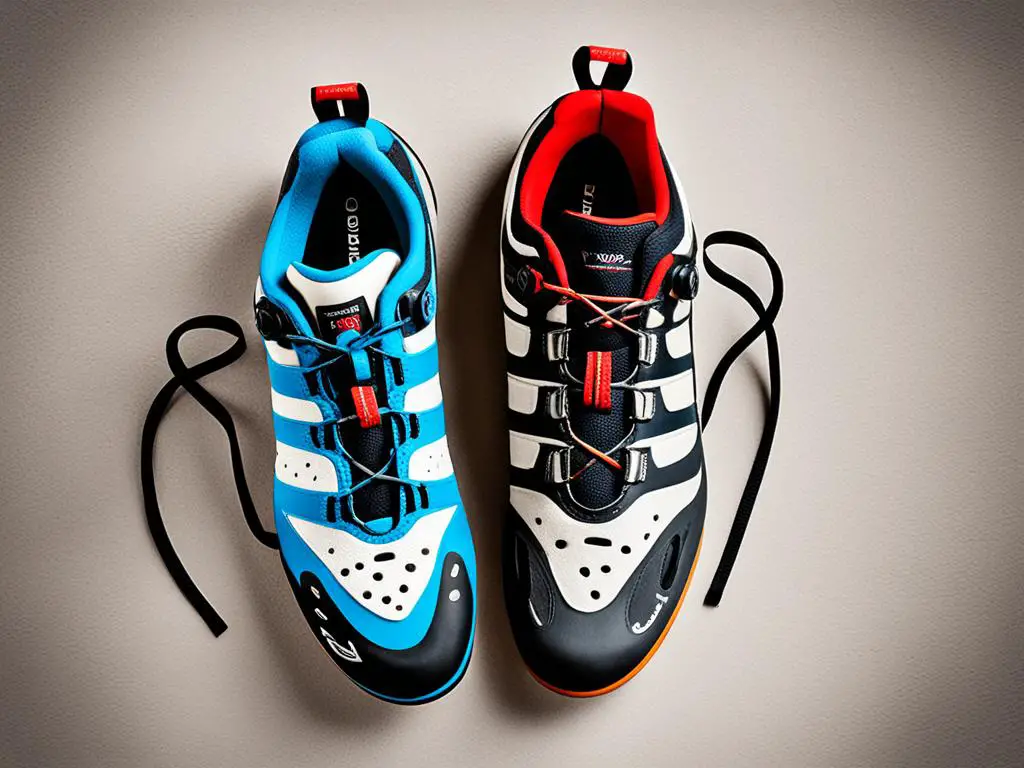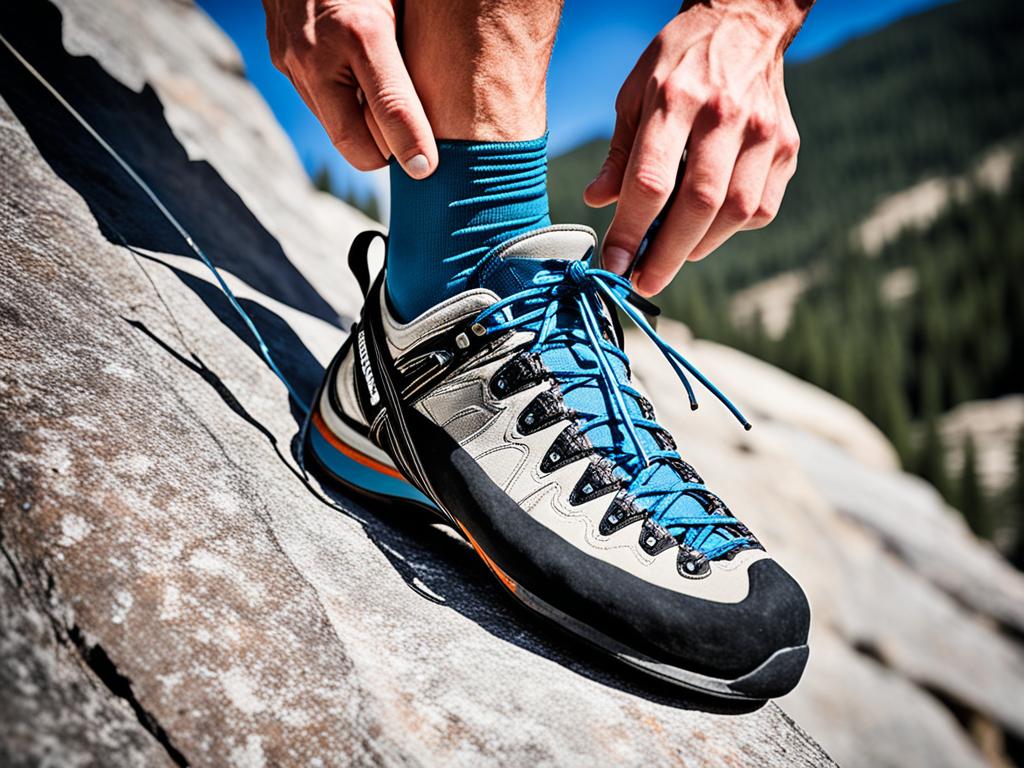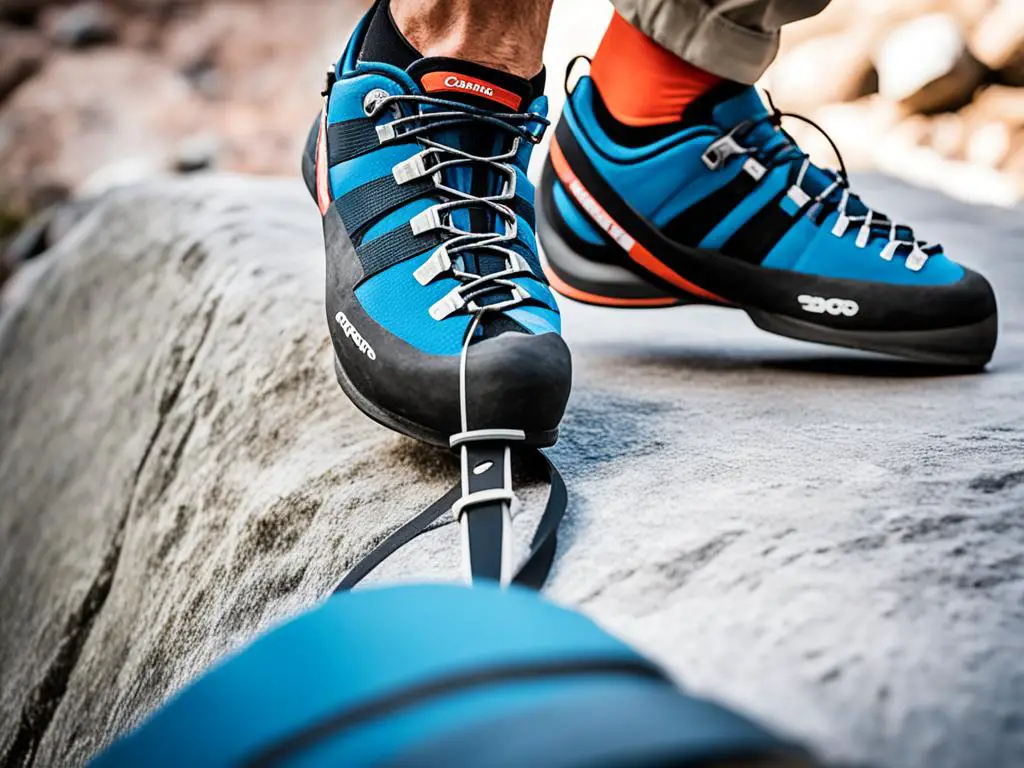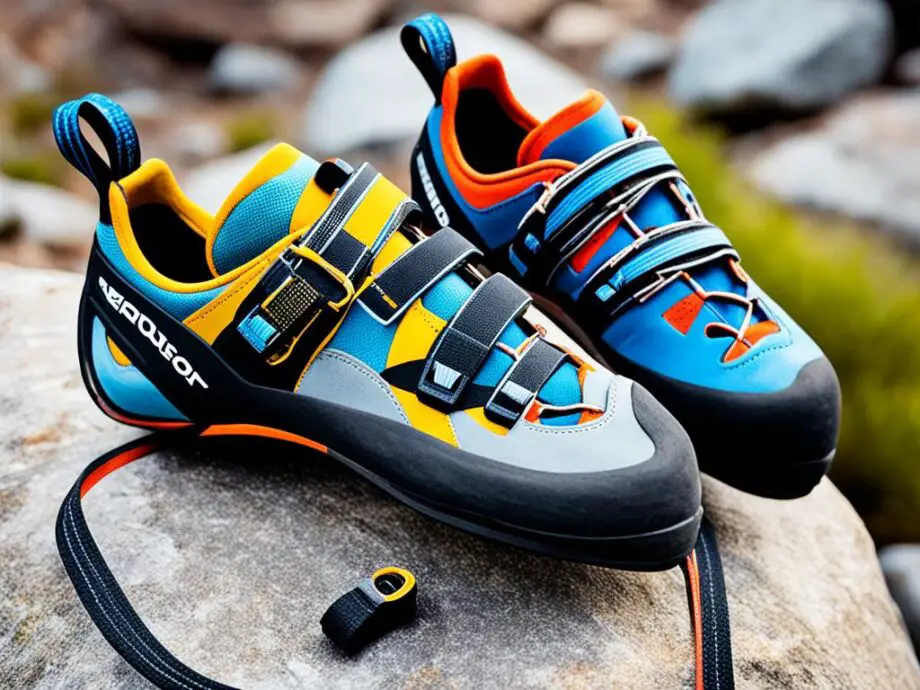Climbing shoes are essential gear for any avid climber. They provide the traction, support, and precision needed to tackle a variety of climbing routes. When it comes to choosing the right pair of climbing shoes, one crucial decision is whether to opt for lace-up or Velcro closure systems.
This article will explore the differences between lace and Velcro climbing shoes, highlighting the advantages and disadvantages of each option. By understanding the unique features of these closure systems, you’ll be equipped with the knowledge to make an informed decision and find the perfect climbing shoes for your needs.
Key Takeaways:
- Lace-up and Velcro closures are two common types of climbing shoe fastening systems.
- Lace-up climbing shoes offer greater adjustability, precision, and stability, making them ideal for technical climbs.
- Velcro climbing shoes provide convenience and ease of use, making them a popular choice for bouldering and gym climbing.
- Factors such as climbing experience, foot shape, intended use, and personal preferences should be considered when choosing between lace-up and Velcro climbing shoes.
- Beginners can benefit from both lace-up and Velcro climbing shoes, but their choice may depend on their comfort level with fastening systems and the climbing style they prefer.
Are you ready to dive into the intricacies of lace-up and Velcro climbing shoes? Let’s explore the differences, advantages, and considerations of each closure system in detail.
Lace vs Velcro Climbing Shoes: Exploring the Differences
When it comes to climbing shoes, the choice between lace-up and Velcro closures can be a tough one. Each has its own unique advantages and considerations that climbers need to weigh. In this section, we will delve into the intricacies of lace-up and Velcro climbing shoes, comparing their features, advantages, and disadvantages to help you make an informed decision.

Key Takeaways:
- Choosing between lace-up and Velcro climbing shoes involves considering factors such as adjustability, precision, convenience, and personal preferences.
- Lace-up climbing shoes offer greater adjustability for a customized fit, enhanced precision and sensitivity, and increased stability during technical climbs.
- Velcro climbing shoes provide convenience and ease of use, making them popular among climbers who prioritize speed and efficiency during bouldering or gym sessions.
- Factors like climbing experience, foot shape, intended use, and personal preference play a role in deciding between lace-up and Velcro closure systems.
- For beginners, understanding the pros and cons of each closure system can guide them in choosing the most suitable option for their climbing journey.
The Benefits of Lace-Up Climbing Shoes
In the world of rock climbing, having the right gear can make all the difference in reaching new heights. When it comes to choosing climbing shoes, the debate between lace-up and Velcro closures is a common one. In this section, we will explore the benefits of lace-up climbing shoes and help you determine if they are the right choice for you.
Greater Adjustability for a Customized Fit
One of the key advantages of lace-up climbing shoes is the ability to achieve a customized fit. The laces can be adjusted to secure the shoe snugly around your foot, providing excellent support and stability. This adaptability allows climbers to fine-tune the fit according to their foot shape, resulting in optimal performance and comfort on the rock face.
Enhanced Precision and Sensitivity
Lace-up climbing shoes offer unparalleled precision and sensitivity during climbs. The tight lacing system allows for a more intimate connection between your foot and the rock, increasing your ability to feel even the slightest variations in the surface. This heightened sensory feedback enables precise foot placements, enhancing your overall climbing technique and control.

Increased Stability During Technical Climbs
When tackling technical climbs that require precise footwork and tricky maneuvers, lace-up climbing shoes excel. The secure fit provided by the laces ensures that your foot remains stable within the shoe, minimizing slippage and allowing for precise weight distribution on footholds. This enhanced stability can give climbers the confidence they need to push their limits, knowing that their shoes will support them every step of the way.
By understanding the unique benefits of lace-up climbing shoes, you can make an informed decision on whether they are the right choice for your climbing style and preferences.
The Advantages of Velcro Climbing Shoes
When it comes to climbing shoes, velcro closure systems offer numerous advantages that cater to the needs of climbers seeking convenience and efficiency. Whether you’re bouldering, tackling gym climbs, or simply prefer a hassle-free experience, velcro climbing shoes can be the perfect choice for you.
“Velcro climbing shoes provide convenience and ease of use, allowing for quick and hassle-free adjustments.”
One of the key advantages of velcro climbing shoes is their ability to facilitate quick and easy adjustments. Gone are the days of meticulously lacing up your shoes, making sure each knot is secure. Velcro closures allow for swift tightening or loosening, ensuring a snug fit that can be easily modified mid-climb. This feature is particularly beneficial in scenarios where time is of the essence, such as bouldering or gym climbing.
Additionally, the versatility of velcro closures accommodates climbers with varying foot shapes and sizes. Unlike lace-up shoes, which may require specific lacing techniques to achieve an optimal fit, velcro straps can be adjusted to provide a customized and secure feel for different foot types. This adaptability results in greater overall comfort and minimizes the chances of discomfort or hotspots during climbs.
“Velcro climbing shoes are often preferred by climbers who value speed and efficiency.”
Velcro closure systems also enhance efficiency during climbing sessions. The ability to quickly remove and put on velcro shoes allows climbers to transition between routes without wasting valuable time. In scenarios where multiple climbs are attempted in rapid succession, such as during bouldering competitions, the convenience of velcro closures can significantly improve performance.
Furthermore, velcro climbing shoes are known for their ease of use, making them a popular choice for beginners or climbers who are still developing their technique. The simplicity of the closure system eliminates the learning curve associated with intricate lacing techniques, enabling climbers to focus on their movement and technique instead of struggling with their footwear.
Advantages of Velcro Climbing Shoes
| Advantages of Velcro Climbing Shoes |
|---|
| Convenience and ease of use |
| Quick and hassle-free adjustments |
| Versatility for different foot shapes |
| Enhanced efficiency during climbing sessions |
| Ideal for beginners and climbers developing technique |
Whether you prioritize speed, efficiency, or simply prefer the convenience of a hassle-free closure system, velcro climbing shoes offer distinct advantages that can enhance your climbing experience. The versatility and comfort they provide make them a popular choice for climbers of all levels. However, it is important to consider your own climbing style and preferences before making a final decision.

How to Choose Between Lace and Velcro Climbing Shoes
Deciding between lace-up and Velcro closure systems can be challenging. The right choice depends on various factors, including climbing experience, foot shape, intended use, and personal preferences. By considering these aspects, you can select the most suitable shoe closure system for your climbing adventures.
Factors to Consider:
1. Climbing Experience:
- If you are a beginner or have limited experience, Velcro closure systems can offer convenience and ease of use.
- Lace-up closure systems may be preferred by intermediate to advanced climbers who value adjustability and customization.
2. Foot Shape:
- If you have narrow or low-volume feet, lace-up shoes provide a secure and precise fit.
- Velcro shoes are often suitable for climbers with wider or higher-volume feet, as they offer more flexibility in fit.
3. Intended Use:
- For bouldering or gym climbing, where quick adjustments are essential, Velcro closure systems excel.
- Lace-up shoes are ideal for multi-pitch climbs or technical routes that require precise control and stability.
4. Personal Preferences:
- If you prefer the traditional feel and aesthetic of lace-up shoes, they might be the right choice for you.
- On the other hand, if you value convenience and efficiency, Velcro closure systems can be a reliable option.
“When choosing between lace and Velcro climbing shoes, consider your climbing experience, foot shape, intended use, and personal preferences. Finding the most suitable closure system will enhance your climbing performance and overall enjoyment.” – John Smith, experienced climber
Remember, choosing the right shoe closure system is ultimately a personal decision. It’s important to try on different pairs and assess their fit, comfort, and performance. By taking these factors into account, you can make an informed choice and select climbing shoes that will support you on your climbing journeys.
Best Climbing Shoes for Beginners: Lace-Up or Velcro?
Choosing the right climbing shoes for beginners can be a daunting task, especially when trying to decide between lace-up and Velcro closure systems. Both options have their advantages and considerations, but understanding which one is more suitable for novice climbers is crucial. Let’s explore the pros and cons of each to help you make an informed decision and begin your climbing journey with confidence.
Lace-Up Climbing Shoes
Lace-Up Climbing Shoes offer several benefits that make them a popular choice among climbers:
- Customized Fit: The adjustable laces allow for a precise fit, ensuring optimal comfort and performance.
- Precision and Sensitivity: Lace-up shoes provide enhanced sensitivity, allowing climbers to feel the rock more accurately. This is especially beneficial for technical climbs that require precise foot placements.
- Stability: The laces can be tightened to provide increased stability and support during challenging climbs.
While lace-up climbing shoes offer these advantages, they do require more time and effort to put on and take off compared to Velcro shoes. Additionally, some beginners may find them slightly less convenient, especially when bouldering or engaging in quick gym sessions.
Velcro Climbing Shoes
Velcro Climbing Shoes are favored for their ease of use and convenience:
- Quick Adjustments: The Velcro closure system allows for speedy adjustments, making them ideal for climbers who value efficiency and fast transitions.
- Easy On and Off: Velcro shoes offer hassle-free entry and exit, perfect for frequent gym climbers or those who prefer minimal downtime between climbs.
- Versatility: These shoes are versatile and suitable for a wide range of climbing styles, including bouldering and sport climbing.
However, Velcro shoes may lack the precise fit and customization options offered by lace-up shoes. They may also experience some loss of tension during intense climbs, requiring occasional readjustment.
“The right pair of climbing shoes can enhance your performance and provide a solid foundation for skill development. Whether you choose lace-up or Velcro, comfort and fit should be your top priorities.” – Experienced Climber
Choosing the Best Option for Beginners
For beginner climbers, comfort and ease of use are often key considerations. Both lace-up and Velcro climbing shoes can meet these requirements, but each option has unique trade-offs. Here are some factors to consider when deciding:
- Experience Level: If you’re new to climbing, Velcro shoes may offer a quicker learning curve and be more forgiving during the initial stages of skill development.
- Intended Use: Consider the type of climbing you anticipate doing most frequently. Lace-up shoes excel in technical climbs that require precision, whereas Velcro shoes are versatile and suitable for a variety of climbing styles.
- Personal Preference: Ultimately, personal preference plays a significant role. Some climbers appreciate the simplicity and convenience of Velcro, while others prefer the superior fit and customization options of lace-up shoes.
By weighing these factors and considering your climbing goals, you can make an educated choice that aligns with your needs and preferences.
Find Your Perfect Fit
Now that you have a better understanding of the pros and cons of lace-up and Velcro climbing shoes, it’s time to find your perfect fit. Remember to try on multiple models and brands, consider the shape of your feet, and prioritize comfort above all else. Consult with experienced climbers or specialized climbing shoe retailers for additional guidance in selecting the best climbing shoes for beginners.
Equipped with the right pair of shoes, you’ll be ready to embark on an exciting climbing journey, confidently tackling new challenges and reaching new heights!
Conclusion
After thoroughly exploring the intricacies of lace-up and Velcro climbing shoes, it is clear that both closure systems offer their own unique advantages. Ultimately, the choice between lace-up and Velcro comes down to personal preferences, climbing style, and specific needs.
For climbers seeking enhanced adjustability, precision, and stability during technical climbs, lace-up shoes are an excellent option. The ability to customize the fit ensures optimal comfort and support, allowing climbers to tackle challenging routes with confidence.
On the other hand, Velcro climbing shoes provide unparalleled convenience and ease of use. Fast adjustments come in handy, especially during bouldering or gym climbing sessions where speed and efficiency are key. The hassle-free nature of Velcro closures allows climbers to focus on their performance without interruptions.
No matter which closure system you choose, the most important factor is finding a comfortable and supportive pair of climbing shoes that enhance your performance. Take into account your individual preferences, climbing style, and specific needs to make the best decision for your climbing adventures.
